on plastic chairs, assault weapons and space robots
In defense of the monobloc chair, and Todd Field’s Tár
25 Mar 23 | Vol 2 Issue 10
I had a friend who would say there is beauty in everything. It turns out that they weren't really my friend, which allows me to say I found this statement a tad pretentious, in wanting to sound profound and nonconformist, the desire to exhibit a sort of Kerouac beat wisdom.
No one made a great maxim using the word "most", there is beauty in most things that don't really carry the same ring. Then again, orthodoxies and maxims are used as validations for violence and war. By 2009 approximately 100,000,000 Kalashnikov rifles had been manufactured. The world population in the same year was around 6,872,767,000. That means every 68th person on the planet owned an AK-47.
A fact that does not put the human race in a good light. Pedro Reyes, an artist from Mexico, turns weapons seized from the Government into automated musical sculptures.
Turning Weapons Into Instruments | Pedro Reyes 'Disarm'
Reyes allows us to turn "there is beauty in everything" to "beauty can be made from anything". Which sounds a little more honest.
I knew this friend had watched American Beauty – a film which demonstrates what happens when guns aren't turned into art – and they were paraphrasing the classic plastic bag scene.
American Beauty ~ Plastic Bag Scene, directed Sam Mendes, script Alan Ball
Do you want to see the most beautiful thing I ever filmed? It was one of those days when it's a minute away from snowing. And there's this electricity in the air, you can almost hear it, right? And this bag was just... dancing with me ... like a little kid begging me to play with it. For fifteen minutes. That's the day I realized that there was this entire life behind things, and this incredibly benevolent force that wanted me to know there was no reason to be afraid. Ever. Video is a poor excuse, I know. But it helps me remember ... I need to remember...
Sometimes there's so much beauty in the world ... I feel like I can't take it... and my heart is just going to cave in.
American Beauty, Alan Ball, 1999
Did you know Sam Mendes changed the ending to a happier one from Alan Ball's original script? [1 ]
The point is that the plastic bag isn't beautiful, it's its interaction with the protagonist that creates the beauty.
Every sixty eighth person owning a semi automatic assault rifle seems to vindicate Gort's diagnosis that humankind is a scourge.
The Day the Earth Stood Still, Klaatu's Speech (1951)
There are an estimated two billion plastic chairs in the world. The actual figure is unknown, as is the original designer of such a ubiquitous object. I see an almost imperceivable movement of Gort’s head in acknowledgement of his suspicions, that it's easier here on planet Earth to search for the quantity of a type of weapon made and sold illicitly, than an object freely available and harmless.
It's likely the number of chairs that have been produced is in the billions [2 ], there are now said to be more than a billion of them worldwide [3 ]. The last estimate is from 2014 so I'm going for a simple two billion as minimum.
That's a plastic chair for roughly every three and a half people here on earth. A specific plastic chair. The Monobloc. The one-piece plastic garden chair.
For it to be a true Monobloc, it needs to meet two conditions. First, to be made of polypropylene, a thermoplastic polymer. Second, it has to be injection moulded as a single piece of plastic. You may want to add stackable to that list, since almost all of them can be piled high into interlocking, tottering towers.
For something so commonplace the origins are unknown. In the twenties experiments were made using plywood or metal bent into form from a single sheet. Dreams of mass production would take the sixties to happen, and one word... plastics.
Prototype contenders are Danish designer Verner Panton's Panton Chair (1958-68), German architect Helmut Bätzner's Bofinger Chair (1964-68), and Italian designer Vico Magistretti's Selene (1961-68). All mass produced, but all also designer pedigree with a price point to match.
In 1972, French engineer Henry Massonnet, standing on the bendy plastic legs of his predecessors, put into production the Fauteuil 300, which took two minutes to go from a melted squirt of plastic to a free standing chair.
The Monobloc chair is reviled by the designer community, only recently allowed into design museums. I suspect in the same spirit that Comic Sans is acknowledged in graphic magazines, in a half ironic way. That you can't be a guardian of knowledge and ignore the most famous prodigy. To ignore the most common and frequently copied pattern simply because it's mass produced, made in China, doesn't wear its designer label on its leg. It's loved by the people for its practicality, with no discerning taste needed in the purchase decision. To exclude it on those grounds would signify that the curators come from privileged, educated, judgemental positions.
I owned some in my garden when I lived in London, part of the furniture as they say, unnoticed. It wasn't until I moved to Hong Kong, and the island of Lamma in particular that I began to see the Monobloc. To view it as a thing in its own right, worthy of praise and affection.
Lamma is a unique place in the world. A magical place. It takes thirty minutes to get there, riding the passenger ferry from Central, Hong Kong — that gleaming, flashing, sparkling edifice of LEDs, neon, mirrored glass and metal, famous for signifying the city of commerce and technology — to arrive at Yung Shue Wan. A passenger ferry, as Lamma has no roads, no cars. If you've been out drinking in the bars of Lan Kwai Fong and caught the last ferry back, you arrive in virtual silence, the humidity visible in the street lights as a mist, a soft focus camera effect. Only the cicadas to keep you company as you walk home along elevated concrete paths, jungle either side, keeping an eye out for snakes loitering ahead of you.
Everything on Lamma came across on the passenger ferry. The Monobloc chair reigns supreme. Most restaurants use them. The trendy gweilo bar has them in lurid fluorescent pink.
There are three ferry piers, one at each end of the island, sleepy Pat Kok which has only a shop that sells beer and pot noodles, at the other end is Sok Kwu Wan, two streets big, First Street made of seafood restaurants and Second Street a small road of residences and a police station. There is a Third Street, although it has about three houses on it. It is not somewhere you can get lost in. With Yung Shue Wan in the middle. There are no cross island ferries. You have to walk.
The concrete path that runs across the island is called the Family Trail since, by local standards, it's a breeze. To anyone else it's made of hill, winding through and up jungle, either in a sauna, or in a sauna in pouring rain. Five kilometres from YSW to the fish farms of Sok Kwu Wan. Five kilometres of what I call mountain and they call light hills. [4 ]
There is virtually nothing on the way, except a very enterprising family who sell frozen pineapples and bottled water from cooler boxes they trundled up the slopes on a wooden trolley. And Monobloc chairs. Come across a flat spot of ground, 112 metres above sea level, overlooking the outlying islands and container ships traversing the South China Sea , and there will be two, or three, or four Monobloc chairs.
Someone has carried these chairs up a steep, humid path to deposit them there, for anybody to sit with friends and enjoy the view. Paid for, hauled and donated the seating, as what can be better than a hike with friends, resting in a panoramic spot, taking in the view, talking.
The determination and generosity in this act of sharing, couldn't work without the lightweight nature of the plastic. Wooden chairs would rot within months. These are objects moulded with one single purpose, a sole requirement, to allow people to gather, resting, talking, anywhere in the world. Impervious to the elements, utilitarian in their composure and design. There is no elite, no chair better than another, every Monobloc is created equal, stacking together, working as a team.
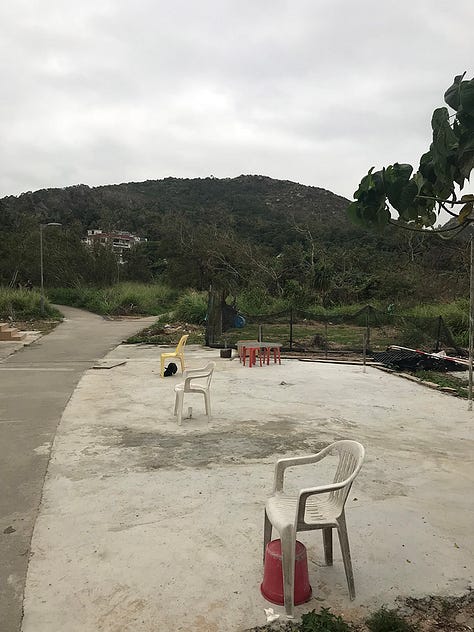
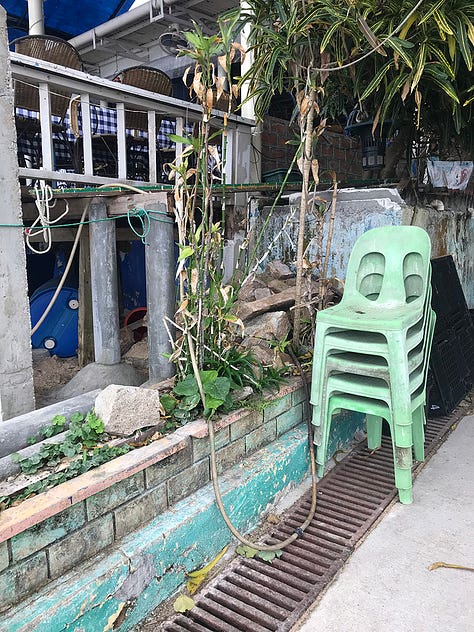
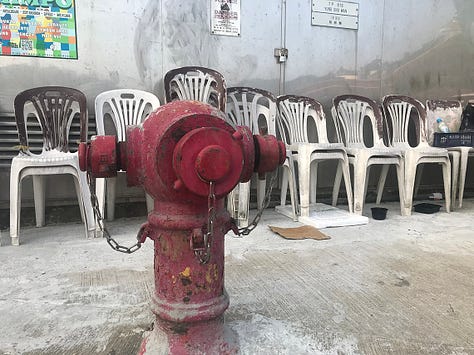
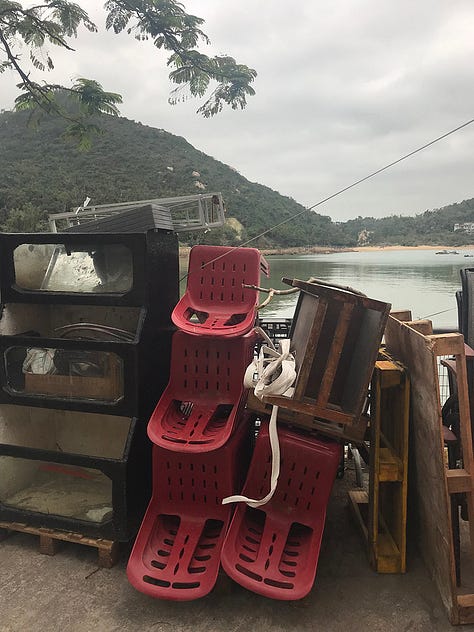
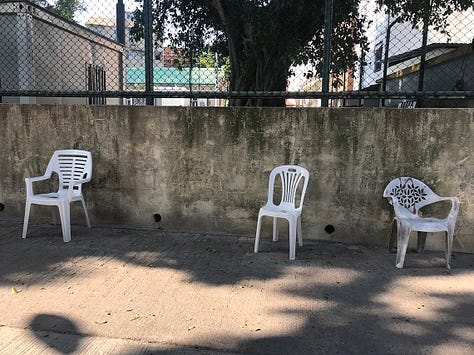
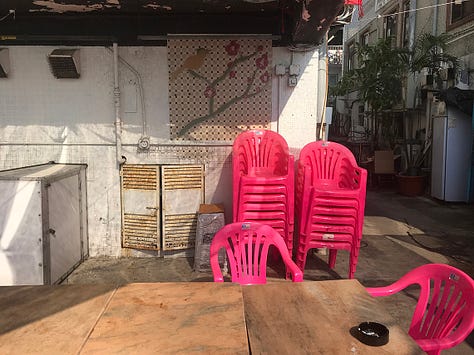
When Gort rocks up with his laser death ray, ready to terminate humanity — a species that has manufactured enough of just one single type of gun, so that every sixty-eighth person grasping one, could, with the 123 bullets the magazine holds, kill everyone alive, three times over. When Gort rocks up, I would ask him to wait a moment, and show him the plastic Monobloc chairs of Lamma, furnished by people we'll never meet, so every third person on the planet can sit, these chairs that have been left by strangers, for other strangers, for their comfort, to rest, to indulge and enjoy a sense of peace. Gort, of course, is probably too heavy to actually sit on a Monobloc, but that's his problem.
The Monobloc chair is not an ugly plastic chair, it is the symbol of our sociability, our desire to gather, to communicate, to celebrate, to join together.
Off you fuck, Gort.
This week’s column is dedicated to all those who have Monoblocs as household furniture.
I watched Todd Field’s Tár after much chatter on the Dirt Discord, especially in relation to the divided opinion about it’s end and cancel culture. I also learned a lesson. Whenever I see the word drama, I tend to switch off, and end watching something action. I then spend ninety minutes bemoaning how predictable it is. It seems I like dramas, if only I can let go of my preconceptions. After all, Thomas Vinterberg's Festen is one of the most intense film experiences I’ve witnessed.
Tár is also intense. It is also cold. Its soul is stainless steel, no chrome, no colour in the reflections, the abundance of polished concrete in it’s sets seems warm compared to the austerity and precision of the main character. There is fire, lots of polished dark wood, the passion of Mahler’s music, but everything is in service to the craft. To Art. With a capital A.
The internet describes it as a film about cancel culture and #metoo. I think that’s wrong. Using a lesbian as the perpetrator is a clever move. It removes the obvious patriarchy critique (we know that’s horribly wrong already) allowing us to view how power and fame allow abuse. I used to work for pop stars. No naming names, but there’s a certain amount of topicality in viewing it this week, as that friend who saw beauty in everything, except perhaps friendship, was in the world of pop stars.
Tár is about how we allow the diamond sparkle of fame to excuse all kinds of abusive behaviour in artists. A business person behaving like that would quickly develop a reputation as a bully. Whereas creatives are excused, as if genius merits cruelty. Perhaps cruelty is wrong, since selfishness, in the service of creating Art, doesn’t even see other people.
It’s a monumental piece of filmmaking. There isn’t a scene without constant dialogue, except when we’re listening to music. Unlike Krzysztof Kieślowski’s Three Colors Blue, Tár lives and breathes in the world of conducting and composing, the experience of being an orchestra member, the politics of performance, and its embedment in education. So when the music plays you need to listen, to pay attention, the same way you do to dialogue. You have been educated, and if you don’t understand, you have failed her, failed to grasp the passion and clarity of Lydia Tár’s interpretation.
It is the most accurate representation of a pop star I’ve seen. The disposal of all those who no longer met their exacting standards in creating Art. Loyalty does not exist, emotions are to be imagined, never shared, given, acknowledged. It’s not about cancel culture per se, it’s simply set now, when mobile phones exist. For the first time stars can not be protected by the spin of the publicity machine. Out of context from performance, their ego, privilege and cold dismissal of all those who serve their art breaks through in the unblinking stare of the mobile phone lens.
There’s debate about the meaning of the ending. For me I think it’s meant to be read as being true in all possible interruptions. Just like each interpretation of Mahler’s Fifth brings out a new truth in it. A virtuoso performance, a scalpel and microscope on how our worship of celebrity endorses the abuse of power, shot through the Hitchcockian psychological ambiguity of Olivier Assayas’ Personal Shopper, Darren Aronofsk’s Black Swan, and even shades of Luca Guadagnino’s Susperia, and a meticulous Kubrickian attention to detail , an imersement in the world of conducting.
I also watched Cocaine Bear too, which was dumb, and incredibly good fun. Both recommended.
This week’s heroes are two generic Monobloc chairs expertly rendered by our artist in residence, Fatima Fletcher. Show Fatima your appreciation by following fatima.fletcher on Instagram. Her work is for sale at fatimafletcher.com, where she’s available for commissions. Her wonderful orchid place mats are for sale at fatima-fletcher.square.site/s/shop.
This week featured
https://en.wikipedia.org/wiki/Monobloc_(chair)
Buy me a coffee at www.buymeacoffee.com/vfnIE9P0Ta
References






Hi Julian, is there an email where I can reach you at? I have a question for you. Thanks
Veronica
Lamma Island was so amazingly unexpected; so unHongKong. A Thing of beauty indeed.
And I must confess to a sneaking affection for Comic Sans, so unfairly maligned.